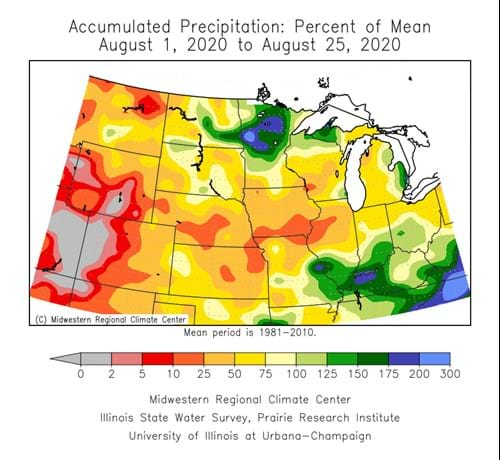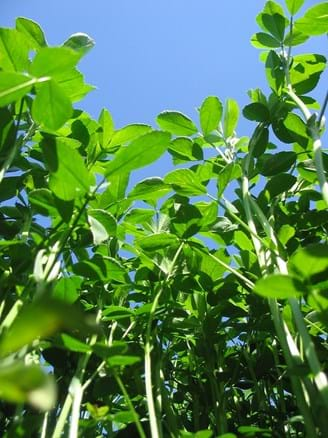Agronomy Update: Advice Regarding Summer Drought Concerns; Applying Crop Nutrients for Alfalfa
BY DAIRYLAND SEED AGRONOMY TEAM
Impact of Late Summer Drought
Much, if not most, of the upper Midwest corn and soybean belt is experiencing a late summer drought. This includes nearly all of the Dairyland Seed footprint.
I remember thinking about the first of August that, if we received normal August rainfall, we could have a good to very good crop. That was only three weeks ago…………. How things have changed………… With lack of rainfall and high temperatures, we are seeing moderate to severe negative impact on both corn and soybeans.
Impact on Corn:
- Firing, or the yellowing of the plant from the ground up. This is due to lack of rainfall, lack of nitrogen uptake, and the translocation of nitrogen and other nutrients from the stalk and lower leaves into the ear as the plant tries to finish the kernels.
- Kernel abortion on the ends of the ear. As the plant does not have enough moisture and nutrients to finish all the pollinated kernels, some kernels at the tip end have been aborted and will dry up.
- Kernel size: At a certain point, the plant will stop kernel abortion and “finish” the kernels it saves. With prolonged drought and accompanying lack of nutrients, kernel size will be negatively impacted. Kernels all along the ear will finish smaller than normal, reducing yield.
- Test weight: Test weight will be lower than normal, potentially significantly so, as the plant lacks the resources to “pack the kernel full”. Light test weight, or chaffy, grain, will be the result.
Impact on Soybeans
- The time-honored and proven adage “August makes the bean crop” comes into play directly.
- Usually good rainfall in August produces a top cluster of blossoms and pods that adds “that last five bushels”. That will not happen in most places this year.
- As soybeans are an indeterminate crop, blossom, pod, and bean development are all going on at the same time. We can expect some blossom and small pod abortion. We can also expect some bean abortion, i.e. a pod that pollinated three beans will abort one or two. That will go on as long as the drought continues.
- Bean size will be reduced. At some point the plant “decides” to keep some beans, and those beans will be reduced in size the longer the drought, and resulting lack of nutrients, continues.
How much will yields be reduced? It is impossible to give bushels or percentage of yield reduction. Rainfall at any point will help greatly; the longer we stay dry the bigger the impact on yield.
What can you do? Very little, except to adjust your expectations and marketing plans, and to be prepared to harvest early as the crop matures prematurely. In future conversations we’ll discuss late season stalk issues due to drought and the resulting need to manage harvest aggressively.

Corn Silage Harvest Timing
The droughty conditions we are experiencing across the Midwest are forcing many livestock producers to test their silage moisture and even target some of the lighter soils that are starting to burn up. This added field variability increases the importance of getting out in the field and collecting moisture samples or chopping a few loads. Remember that the trade-off with regards to silage moisture is high fiber digestibility and low starch in wet silage OR low fiber digestibility and high starch in dry silage. As we like to say, “it’s more difficult to add fiber digestibility to dry silage than it is to add starchy grain to a wet silage!” So, even though September is still a week away, it’s good to see many people pulling the choppers out of the yard to stay ahead of the crop.
Whole plant moisture is the best way to evaluate your silage crop, since ear and whole plant development vary between hybrids and environments. Again, this is exaggerated in droughty conditions, so the larger the sample the better. With these increased variables, just remember to keep is simple:
- Determine an average moisture target: 68 percent moisture is generally the sweet spot for a bag or bunker. Silos can go to the mid to low 60’s. Nutritionists may want to adjust your target based on your ration needs (starch versus digestibility).
- Measure current whole plant moisture: Select representative plants from your field after kernel dent, chop them soon after cutting and measure moisture using an NIR or oven drying method. In highly variable fields, collect more samples, or chop a couple loads.
- Project a start date: corn dries in the field at a rate of about 0.5 percent moisture per day in September, faster in this hot weather. Factor in the time required to harvest and plan to start harvesting before the crop reaches your average moisture target and finish shortly after drying past it. Many scenarios require us to start harvesting when moistures are in the low 70’s to avoid silage that is too dry by the time we finish.
Applying Crop Nutrients to Alfalfa This Fall

As the days of summer start to shorten and autumn and harvest draw closer, we need to take a few minutes to look at our alfalfa stands. What we are going to keep and what will we rotate back into another crop for the next growing season? If we are going to rotate to another crop next year, we may need to look at weed control for perennial weeds this fall. Otherwise, our main concern is whether we do tillage and when.
If we are going to keep the stand, we need to fertilize it. In most situations it is highly recommended to split apply the nutrients that alfalfa needs with a percentage after first crop and the remaining after last cutting. It is a common practice in many areas to split the percentage in half with the mobile nutrients Sulfur and Boron being applied in the spring after first cutting and the remainder after the last cutting. This not only helps make nutrients more available in most instances, it also allows for better cash flow by not having to pay for all of your crop nutrients/fertilizer needs at one time.
“How much do need to apply” is a common question. The almost more common response is “how many tons have you removed or what is your yields goal”. Remember one ton of alfalfa has a crop removal of 51-12-49-.015 Boron and 5.4 Sulfur, as to the 51 units of Nitrogen in almost all instances you will not need Nitrogen for alfalfa as it is a legume that fixes its own Nitrogen.
If you are harvesting five tons of alfalfa you are removing:
- 255 units of N
- 60 units of P
- 245 units of K
If you have already fertilized this spring, review your needs by subtracting what you applied from the tons you have removed or your yield goal. If you have not fertilized yet this growing season the question becomes, do you put it all on now or do you split apply it and then apply some after first crop next spring?
If you do not replace the crop nutrients that you have removed, odds are you are reducing the life of the stand. In many instances I see more winterkill of alfalfa on fields with lower fertility levels, especially lower K or potash levels. It is important that if you apply nutrients after your last cutting that you allow enough time for those nutrients to move into the soil solution prior to freeze up. A slow .5 to 1 inch rain seems to help with this immensely. That is why it is recommend to fertilizer sooner after the last cutting versus later.
Lastly, if you are looking at seeding alfalfa next spring, check the pH of the field(s) you will be seeding into and if lime is needed to correct the pH, apply that product this fall. This allows the lime a chance to work into the soil solution and start correcting low pH.
If you have questions regarding this or other agronomic issues, please contact our Dairyland Seed Agronomist.
Corteva Technology Use Agreements
All growers with orders for any Corteva Agriscience brand seed product, regardless of crop or trait (including non-GM products) need to have a signed Corteva Technology Use Agreement in place by September 1. Growers should sign the Corteva Technology Use Agreement electronically at www.agcelerate.com. Signing electronically is preferable, however, paper copies are available at www.traitstewardship.com.
 |
 |
 |
 |
 |
| Brian Weller Western Region 507.456.3034 |
Dan Ritter Central Region 219.863.0583 |
Branden Furseth Northern Region 608.513.4265 |
Rod King Eastern Region 574.596.6721 |
Terry Jones Eastern Region 419.630.3115 |
